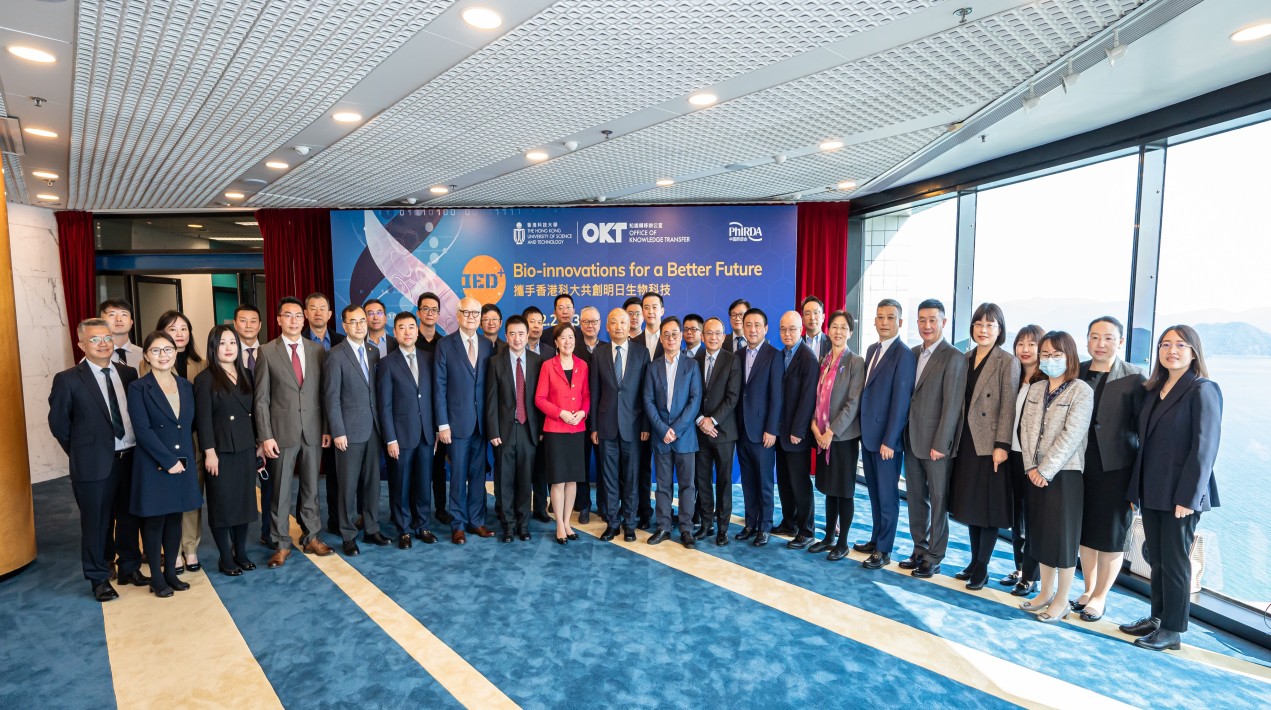
The Hong Kong University of Science and Technology (HKUST) and the China Pharmaceutical Innovation and Research Development Association (PhIRDA) signed a Memorandum of Understanding (MoU) to establish two research and innovation centres with the goal of strengthening Hong Kong’s capabilities in pharmaceutical innovation and commercialisation. The partnership aims to make contribute significantly to pharmaceutical innovation and development in the Greater Bay Area and beyond.
A delegation of members from PhIRDA, which consisted of representatives from more than 20 renowned pharmaceutical companies, visited HKUST to acquire knowledge about the University’s latest research outcomes in the field of life and health sciences.
The agreement was signed by the Vice-President for Research and Development (VPRD) of HKUST, accompanied by other representatives including the President of HK Bio-Med Innotech Association and the Chairman of PhiRDA, witnessed by the University’s President and other attendees.
As per the Memorandum of Understanding, the two entities will collaborate by leveraging the University’s expertise in fundamental research and the Association members’ proficiency in knowledge transfer capabilities in pharmaceutical innovation. They will establish the “Greater Bay Area Center for International BioMed Innovations” together to enhance basic research and accelerate the commercialization of research outcomes.
Additionally, HKUST and PhIRDA will establish the “Greater Bay Area Center for Policy Research on BioMed Development” to undertake research on the regulatory science of drugs and medical devices. The centre will also offer policy recommendations to the relevant authorities in mainland China and Hong Kong.
This initiative may also include offering courses to cultivate skills related to pharmaceutical innovation, regulation, and research and development management. The Center will further promote the establishment of a review and approval mechanism for drugs and medical equipment in Hong Kong and will work towards aligning the regulatory mechanisms between Hong Kong and mainland China.
The President of HKUST announced that the HKSAR Government has allocated HK$6 billion towards the creation of life and health technology research institutes, aimed at fostering collaboration between universities and institutions. In line with this initiative, HKUST has partnered with PhIRDA to establish two innovation and research centres.
The President expressed confidence in the collaboration, citing the University’s expertise in life and health tech research, as well as the R&D and commercialization capabilities of PhIRDA’s member organizations. The partnership is expected to propel R&D in pharmaceutical innovation and contribute to the advancement of pharmaceutical regulations across borders, while also promoting the development of life and health technology in the region.
The Executive President of PhIRDA commented on the significance of biomedical science for developed economies around the world. The President expressed confidence in Hong Kong’s capabilities to make significant breakthroughs in biomedical innovation, given strong support from the Motherland and the city’s expertise in basic research.
PhIRDA is pleased to collaborate with HKUST to establish the “Greater Bay Area Center for International BioMed Innovations” and the “Greater Bay Area Center for Policy Research on BioMed Development.” The collaboration aims to promote the commercialisation of basic research outcomes from higher education institutions and align regulatory mechanisms between mainland China and Hong Kong. Ultimately, this initiative is expected to facilitate the innovative development of drugs and medical devices in the Greater Bay Area.
During their visit, members of the PhIRDA delegation engaged in discussions with HKUST VPRD Prof. Tim Cheng and other members of the university’s management to identify the needs in the development of Hong Kong’s biotech and related industries. The delegation also explored ways to deepen strategic cooperation between the two parties. In addition, HKUST faculty and start-ups presented multiple biomedical research projects to the delegation, highlighting the University’s latest discoveries related to drug therapy for neurodegenerative diseases, cancers, and ageing-related diseases.
















